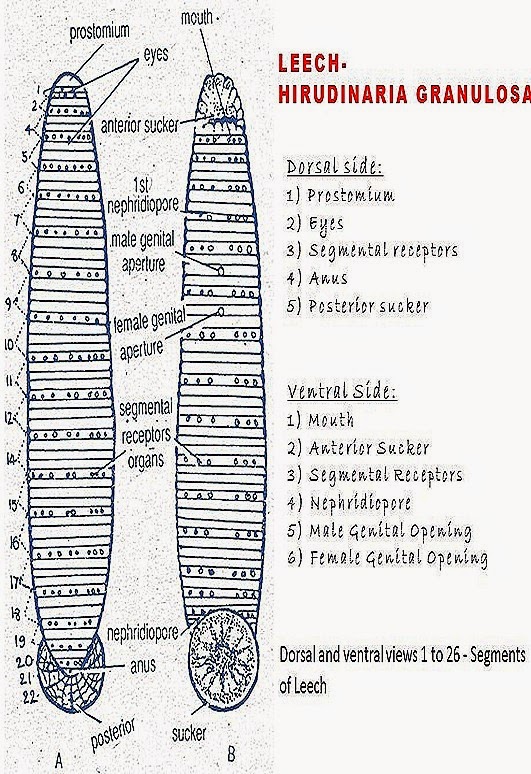HIRUDINARIA-EXTERNAL CHARACTERS
HIRUDINARIA-MORPHOLOGY
The leeches are common in temperate parts of the world. The common cattle leech is found in India, Burma, Ceylon. It is found in lakes, ditches, ponds and slow moving streams. It is sanguivorous parasite, (feeds on the blood of cattle). H. granulosa, H. manillensis, H.javanica, H. viridis are different species met with the genus. leech body consists various kinds of parasitic adaptations for sucking blood from their hosts.
Phylum: Annelida
Class: Hirudinea
Order : Gnathobdellida
LEECH-MORPHOLOGY:
i) Shape and size: Hirudinaria is soft, vermiform, elongated and dorsi ventrally flattened worm. It is 10 to 15 cm long. The body is broad near the posterior and while narrow near the anterior end. The dorsal surface is somewhat convex and the ventral surface is more or less flat.
ii)Colouration : The body of the leech is brightly colored. The dorsal surface is olive-green; the ventral surface is orange-yellow in color. Distinct stripes are seen on the body.
iii) Segmentation of the body: The body is divided into 33 segments. Externally it is divided into more segments which are called annuli. There are 109 annuli in a leech. The number of annuli varies in different segments. A typical segment of the middle part of the body includes five annuli.
iv) Suckers: Body bears 2 suckers. They anterior sucker or oral sucker is oval and ventrally-directed, formed, by the first 3 segments, it includes mouth. At the posterior end of body a circular and highly muscular posterior or anal sucker is formed by fusion of seven body segments, meant for attachment and Locomotion.

v) Regions of the Body: The entire body is divided into 6 regions.
1. Cephalic region
2. Pre-clitellar region.
3. Clitellar region
4. Middle region
5. Caudal region
6. Posterior region.
1) Cephalic region: It contains first five segments called ocular segments. In this region prostomium, anterior sucker, mouth and eyes are present.
a) First segments contain-one annulus.
b) 3rd segment contains 2 annuli.
c) 4 and 5th segments contain 3 annuli each.
2) Preclitellar region: It consists of 6th, 7th and 8th segments The 6th segment has 3annuliwhile 7th and 8th segments have 5 annuli each. They show nephridiopores.
3) Clitellar region: It consists of 9th, 10th and 11th segments. On the ventral surface of 10th segement in the middle line a male genital opening is present. On the ventral surface of 11th segment female genital opening is present. A temporary clitellum is formed during breeding season. All the segments have 5 annuli each.
4) Middle region: It consists of 12 to 26 segments all show 5 annuli and pairs of nephridiopores.
5) Caudal region: It contains 23 to 26 segments the 23rd segment has three annuli and segments 24, 25 and 26 have two annuli each. On the 26th segment anus is present dorsally.
6) Posterior region: This consists of last 7 single annular segments which unite to form posterior region.
VI) External apertures:
1) Mouth: Mouth is a triradiate aperture present in the anterior sucker.
2) Nephridiopores : 17 pairs of nephridiopores are present. One pair lies ventrally on the last annulus of each segment from 6 to 22 segments.
3) Male genital opening: Male genital aperture is a mid-ventral opening in between second and third annuli of 10th segment.
4) Female genital opening: Female genital opening lies mid-ventrally in between second and third annuli of 11th segment.
5) Anus: Anus is a small opening present mid-dorsally on the 26th segment at the base of posterior sucker.
